AFRICAN SEAFARERS
ref. # 026 African seafarers -Influences
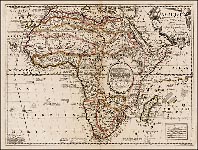 "Another factor was the centuries long conflict between the Iberians and the Muslims to the south. The eastern trade routes were controlled by the Ottoman Empire after the Turks took control of Constantinople in 1453, and they barred Europeans from those trade routes. The ability to outflank the Muslim states of North Africa was seen as crucial to their survival. At the same time, the Iberians learnt much from their Arab neighbours. The carrack and caravel both incorporated the Mediterranean lateen sail that made ships far more manoeuvrable. It was also through the Arabs that Ancient Greek geography was rediscovered, for the first time giving European sailors some idea of the shape of Africa and Asia."
"Another factor was the centuries long conflict between the Iberians and the Muslims to the south. The eastern trade routes were controlled by the Ottoman Empire after the Turks took control of Constantinople in 1453, and they barred Europeans from those trade routes. The ability to outflank the Muslim states of North Africa was seen as crucial to their survival. At the same time, the Iberians learnt much from their Arab neighbours. The carrack and caravel both incorporated the Mediterranean lateen sail that made ships far more manoeuvrable. It was also through the Arabs that Ancient Greek geography was rediscovered, for the first time giving European sailors some idea of the shape of Africa and Asia."©text: us.wow.com
© map: ...
tags: #map #africa #African seafarers
ref. # 026a African seafarers -Carthago Nova
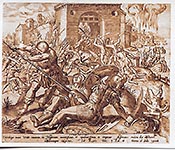 Conquest of Carthago Nova (Cartagena - Spain) by Romans during the 2nd Punic War between Carthage and Rome 210 BC (Pieter Furnius, 16th century, Library of the University of Leiden (NL))
Conquest of Carthago Nova (Cartagena - Spain) by Romans during the 2nd Punic War between Carthage and Rome 210 BC (Pieter Furnius, 16th century, Library of the University of Leiden (NL))©: www.ancient.eu
tags: #Phoenicia #cartagena #chartago nova
026b African seafarers -Phoenicia
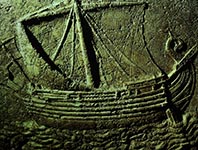 Phoenician ship Carved on the face of a sarcophagus. 2nd century AD.
Phoenician ship Carved on the face of a sarcophagus. 2nd century AD.©: CC en.wikipedia.org/wiki/History_of_Lebanon#Phoenicia
tags: #Phoenicia
ref. # 026c African seafarers -anatomy of a Punt schip
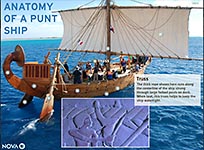 (interactive presentation of) anatomy of an Egyptian Punt ship
(interactive presentation of) anatomy of an Egyptian Punt ship"When researchers set out to create a full-size reconstruction of a pharaonic sailing vessel, as seen in NOVA's 'Building Pharaoh's Ship', they had to rediscover some of the basics of New Kingdom engineering. In this interactive, explore different parts of the ship that its recreators dubbed Min of the Desert."
©: www.pbs.org
tags: #punt ship #egypt
026d African seafarers -Stern-mounted steering oar of an Egyptian riverboat
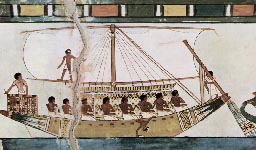 Tomb of Menna, scribe of the king, scene: funeral procession to Abydos, a similar funerary boat is believed to have carried the body of Menna and his wife to Abydos, the place consecrated to the god Osiris. Date: circa 1422-1411 BCE. Mural, 43 73 cm (16.9 28.7 in). Current location: Tomb of Menna, Thebe
Tomb of Menna, scribe of the king, scene: funeral procession to Abydos, a similar funerary boat is believed to have carried the body of Menna and his wife to Abydos, the place consecrated to the god Osiris. Date: circa 1422-1411 BCE. Mural, 43 73 cm (16.9 28.7 in). Current location: Tomb of Menna, Thebe©: via Wikimedia, The Yorck Project: '1000 Meisterwerke der Malerei'. DVD-ROM, 2002. ISBN 3936122202. Distributed by Directmedia Pub.
tags: #Egypt #Menna #riverboat
026e African seafarers -Somalia
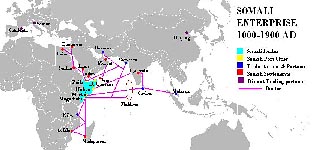 "In antiquity, the ancestors of the Somali people were an important link in the Horn of Africa connecting the region's commerce with the rest of the ancient world. Somali sailors and merchants were the main suppliers of frankincense, myrrh and spices, items which were considered valuable luxuries by the Ancient Egyptians, Phoenicians, Mycenaeans and Babylonians. During the classical era, several ancient city-states such as Opone, Mosylon and Malao that competed with the Sabaeans, Parthians and Axumites for the wealthy Indo-Greco-Roman trade also flourished in Somalia. In the Middle Ages, several powerful Somali empires dominated the regional trade including the Ajuran Sultanate, the latter of which maintained profitable maritime contacts with Arabia, India, Venetia, Persia, Egypt, Portugal and as far away as China. This tradition of seaborne trade was maintained in the early modern period by later Somali states such as the Gobroon Dynasty."
"In antiquity, the ancestors of the Somali people were an important link in the Horn of Africa connecting the region's commerce with the rest of the ancient world. Somali sailors and merchants were the main suppliers of frankincense, myrrh and spices, items which were considered valuable luxuries by the Ancient Egyptians, Phoenicians, Mycenaeans and Babylonians. During the classical era, several ancient city-states such as Opone, Mosylon and Malao that competed with the Sabaeans, Parthians and Axumites for the wealthy Indo-Greco-Roman trade also flourished in Somalia. In the Middle Ages, several powerful Somali empires dominated the regional trade including the Ajuran Sultanate, the latter of which maintained profitable maritime contacts with Arabia, India, Venetia, Persia, Egypt, Portugal and as far away as China. This tradition of seaborne trade was maintained in the early modern period by later Somali states such as the Gobroon Dynasty." ©: maritime history of Somalia (Wikipedia)
tags: #Somalia#East Coast Africa
ref. # 027 African seafarers -Olmec
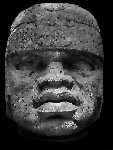 Gigantic stone head of Negritic African during the Olmec (Xi) Civilization
By Paul Barton
Gigantic stone head of Negritic African during the Olmec (Xi) Civilization
By Paul BartonNegritic African: The earliest people in the Americas were people of the Negritic African race, who entered the Americas perhaps as early as 100,000 years ago, by way of the bering straight and about thirty thousand years ago in a worldwide maritime undertaking that included journeys from the then wet and lake filled Sahara towards the Indian Ocean and the Pacific, and from West Africa across the Atlantic Ocean towards the Americas. According to the Gladwin Thesis, this ancient journey occurred, particularly about 75,000 years ago and included Black Pygmies, Black Negritic peoples and Black Australoids similar to the Aboriginal Black people of Australia and parts of Asia, including India. essaysbyekowa.com
©: Paul Barton
tags: #Olmec #Paul Barton #stone heads
027a African seafarers -Cave paintings in the Sahara
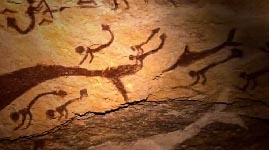 The remote Cave of Swimmers is located at Wadi Sura in the mountainous Gilf Kebir plateau of the Sahara, in southwest Egypt near the Libyan border.
Wadi Sora itself is a sheltered inlet within a promontory of the main plateau. The main painted caves were discovered by the Hungarian explorer LászlO Almásy in October 1933 during the Frobenius expedition. They contain the diminuitive but defined 'swimming figures. www.bradshawfoundation.com
The remote Cave of Swimmers is located at Wadi Sura in the mountainous Gilf Kebir plateau of the Sahara, in southwest Egypt near the Libyan border.
Wadi Sora itself is a sheltered inlet within a promontory of the main plateau. The main painted caves were discovered by the Hungarian explorer LászlO Almásy in October 1933 during the Frobenius expedition. They contain the diminuitive but defined 'swimming figures. www.bradshawfoundation.comlink: en.wikipedia.org/wiki/Cave_of_Swimmers
www.britishmuseum.org
©:
tags: #Gilf Kebir #sahara #mermaids
ref. # 027b African seafarers -Wadi al-Hitan (Whale Valley)
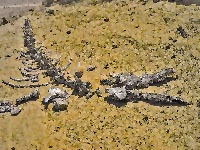 "Wadi Al-Hitan, Whale Valley, in the Western Desert of Egypt, contains invaluable fossil remains of the earliest, and now extinct, suborder of whales, Archaeoceti. These fossils represent one of the major stories of evolution: the emergence of the whale as an ocean-going mammal from a previous life as a land-based animal. This is the most important site in the world for the demonstration of this stage of evolution. It portrays vividly the form and life of these whales during their transition. The number, concentration and quality of such fossils here is unique, as is their accessibility and setting in an attractive and protected landscape. The fossils of Al-Hitan show the youngest archaeocetes, in the last stages of losing their hind limbs. Other fossil material in the site makes it possible to reconstruct the surrounding environmental and ecological conditions of the time." UNESCO World Heritage Site
"Wadi Al-Hitan, Whale Valley, in the Western Desert of Egypt, contains invaluable fossil remains of the earliest, and now extinct, suborder of whales, Archaeoceti. These fossils represent one of the major stories of evolution: the emergence of the whale as an ocean-going mammal from a previous life as a land-based animal. This is the most important site in the world for the demonstration of this stage of evolution. It portrays vividly the form and life of these whales during their transition. The number, concentration and quality of such fossils here is unique, as is their accessibility and setting in an attractive and protected landscape. The fossils of Al-Hitan show the youngest archaeocetes, in the last stages of losing their hind limbs. Other fossil material in the site makes it possible to reconstruct the surrounding environmental and ecological conditions of the time." UNESCO World Heritage Site
picture:: Dorudon atrox bones at Wadi al-Hitan. This fossil skeleton, around 50 million years old, has been partially excavated and reassembled where found in Wadi Al-Hitan. Dozens of whale skeletons remain undisturbed on the floor of the valley, usually indicated by small mounds created as wind erosion uncovered them.
©: Creative Commons Wikipedia
tags: #Wadi al-Hitan #whales
028 African seafarers -Hanno
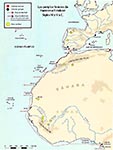 via Greg Mel - Pinterest
via Greg Mel - Pinterest"Hanno the Navigator was a Carthaginian explorer of the sixth or fifth century BC, best known for his naval exploration of the western coast of Africa. The only source of his voyage is a Greek periplus.
"Carthage dispatched Hanno at the head of a fleet of 60 ships to explore and colonize the northwestern coast of Africa. He sailed through the straits of Gibraltar, founded or repopulated seven colonies along the African coast of what is now Morocco, and explored significantly farther along the Atlantic coast of the continent. Hanno encountered various indigenous peoples on his journey and met with a variety of welcomes.
At the terminus of Hanno's voyage, the explorer found an island heavily populated with what were described as hirsute and savage people. Attempts to capture the males failed, but three of the females were taken. These were so ferocious that they were killed, and their skins preserved for transport home to Carthage. The skins were kept in the Temple of Tannit on Hanno's return and, according to Pliny the Elder, survived until the Roman destruction of Carthage in 146 BC, some 350 years after Hanno's expedition. The interpreters travelling with Hanno called the people gorillae, and when European explorers first encountered gorillas in the 19th century, the apes were given this name on the assumption that they were the "people" Hanno described"
(Wikipedia)
©: loads of beautiful pictures of Fenicians www.pinterest.com
tags: #Hanno
ref. # 028a African seafarers -Himilco
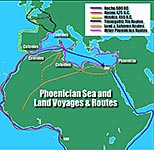 "Himilco, 5th century BC
"Himilco, 5th century BCHimilco is the first known explorer from the Mediterranean Sea to reach the northwestern shores of Europe. His lost account of his adventures is quoted by Roman writers. The oldest reference to Himilco's voyage is a brief mention in Natural History (2.169a). by the Roman scholar Pliny the Elder.[2] Himilco was quoted three times by Rufus Festus Avienus, who wrote Ora Maritima, a poetical account of the geography in the 4th century AD." "Carthaginian voyager, 5th century BC., the first known sailor from the Mediterranean to reach the northwestern shores of Europe. He wrote a story about his adventures, which is now lost. It is quoted, however, by Roman authors, and we are therefore able to reconstruct his travels. The name 'Himilco' is Latin; it renders the Phoenician name Chimilkât, which means 'my brother is milkât' - but it is unclear to us what a milkât was. Read more: Himilco, Phoenician Voyager to Northwestern Shores of Europe.
The oldest available source on Himilco's voyage is Natural history by the Roman scientist Pliny the Elder (23-79 A.D.). He writes: "When the power of Carthage flourished, Hanno sailed round from Cádiz to the extremity of Arabia, and published a memoir of his voyage, as did Himilco when he was dispatched at the same date to explore the outer coasts of Europe." (Pliny the Elder, Natural history 2.169a)"
© Picture: Reproduced by kind courtesy © Jona Lendering for Livius.Org
text: phoenicia.org
tags: #himilco #carthago
ref. # 028b Arab culture -Ibn Battuta
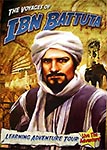 Ibn Battuta Was born in 1304 Tangier, Morocco. Over the years he traveled around Africa, India and China.
Ibn Battuta Was born in 1304 Tangier, Morocco. Over the years he traveled around Africa, India and China.Ibn Battutah, or simply Muhammad Ibn Battuta (February 25, 1304 - 1368 or 1369), was an explorer of Berber descent, who is widely recognised as one of the greatest travelers of all time. He is known for his extensive travels, accounts of which were published in the ´Rihla´ (lit. ´Journey´). Over a period of thirty years, Ibn Battuta visited most of the known Islamic world as well as many non-Muslim lands. His journeys included trips to North Africa, the Horn of Africa, West Africa and Eastern Europe, and to the Middle East 025a, South Asia, Central Asia, Southeast Asia and China.
©: ibnbattutalife.blogspot.nl/
Wikipedia, more: ibnbattuta.berkeley.edu
tags: #Ibn Battuta #arab culture
